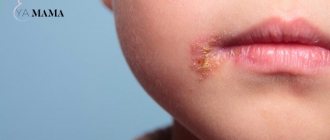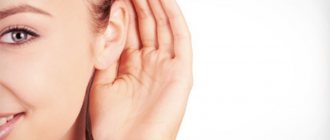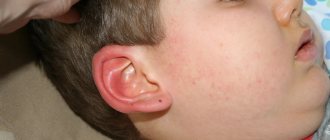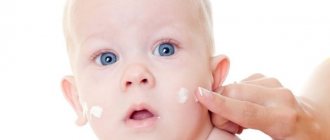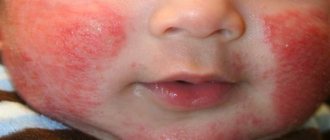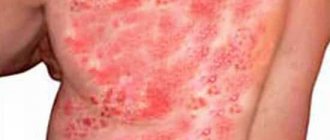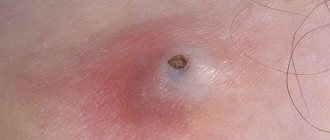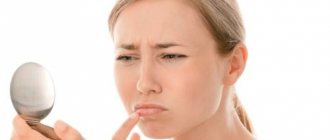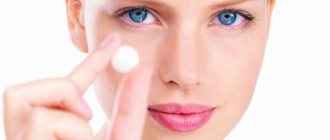The appearance of herpes on the face is accompanied by characteristic symptoms in the form of a rash characterized by burning and itching.
If such clinical signs develop, the patient should consult a doctor who will conduct the necessary examination aimed at identifying the specific type of human herpes virus.
Depending on the identified pathogen, treatment is selected, including etiotropic and symptomatic approaches.
When herpes develops on the skin of the face, the prognosis is favorable, since the pathology is easily treatable, however, in the future, a person may experience relapses of the disease.
About pathogens
photo of herpes on the face
The occurrence of facial herpes is a common clinical situation characteristic of viruses of the herpetic family.
Such pathogens are widespread in the human population and, against the background of decreased immune activity, quickly lead to the appearance of unpleasant symptoms.
The table shows what types of herpes occur on the face:
In clinical practice, there are various types of herpes on the face. In order to select the best means for therapy, the doctor needs to identify the specific type of pathogen.
It is important to note that the appearance of herpes rashes on the face in adults or children does not differ fundamentally between specific types of the virus, which makes diagnosis difficult during external examination.
Carrying out additional studies, for example, polymerase chain reaction, allows you to make an accurate diagnosis.
Preventive measures
To avoid the question of why blisters appeared on the lip or cheek again, after treating the rash, you must constantly follow the recommendations for the prevention of the herpes virus. You can avoid relapses of the disease if:
- Strictly observe the rules of personal hygiene.
- Constantly take care of strengthening your immune system.
- Avoid contact with people who have obvious signs of herpes.
- Eliminate the risk of hypothermia.
- Lead a healthy lifestyle, eat right.
For people whose viral herpetic rash appears on their face too often (more than 3 times a year), doctors recommend undergoing a special preventive vaccination against the virus.
Development of pathology
photo of herpes on the cheek
The main cause of herpes on the skin of the face is the development of immunodeficiency associated with external or internal unfavorable factors:
- old age or neonatal period;
- poor nutrition with low levels of vitamins and microelements in food;
- chronic stress, heavy physical activity;
- decompensated diseases of internal organs, including cancer;
- acute period of infectious diseases and exacerbation of their chronic variants;
- the use of immunosuppressive drugs (chemotherapeutic drugs, glucocorticoids) to treat concomitant pathologies.
All causes lead to a decrease in the activity of components of the immune system, which allows the human herpesvirus to reactivate and lead to the appearance of characteristic symptoms on the face.
Diagnostics
First of all, the doctor conducts a visual inspection of the rash to determine the extent of the damage. The following diagnostic methods are also prescribed:
- Thorough inspection using special instruments. Allows you to assess the extent of damage and determine the stage of development.
- Scraping Tissue particles are scraped off the surface of the rash, which are subsequently sent to the laboratory for examination.
- analysis . It is prescribed to determine the presence of inflammation, exclude other diseases and identify the type of infection.
In some cases, a Balzer iodine test may be performed or a Wood's lamp may be used for visual inspection. Based on the data obtained, medications are prescribed whose active substances will help destroy the virus and relieve symptoms.
Clinical manifestations
photo of herpes on the forehead
Speaking about whether there can be herpes on the cheek, doctors note that such a condition is associated with various types of pathogens and can affect any part of the face.
The occurrence of pathology is characterized by local and general symptoms. General manifestations include a slight increase in body temperature, general weakness, headaches and other signs of intoxication.
Local symptoms of herpes on the forehead and other areas of the face are characterized by a specific rash:
- At the initial stage, a small area of the skin acquires a reddish tint. A characteristic sign of herpes on the face at the beginning of the pathology is the appearance of slight itching in the area of hyperemia;
- Small blisters appear in the area of redness. Their peculiarity is the presence of a transparent liquid inside, which contains a large amount of the pathogen. The bubbles gradually increase in number and size. At this stage of the disease, patients note severe itching, burning and pain, which is often observed with herpes of the facial nerve. The latter disease is associated with herpes zoster;
- 5-7 days after the onset of the disease, the blisters burst, and light crusts form in their place. Subjective sensations in the form of burning and itching disappear, and the crusts disappear after 1-2 weeks, leaving no changes on the skin.
Such transformation of the rash is typical for all types of herpes on the face, regardless of the specific pathogen and its location.
Rashes on the skin may additionally be accompanied by damage to the mucous membranes of the lips, oral cavity and conjunctiva, which brings additional discomfort to the patient.
Masking sores
Herpetic formations on the forehead, especially large ones, spoil a person’s appearance. Before important meetings, dates or work, patients may try to disguise the sore to hide it from prying eyes.
Experts strictly do not recommend doing this, as it leads to several negative consequences:
- Self-infection . If powder or foundation is used, then a small amount of viral pathogens remains on the special stick for applying the substance. They are active within 24 hours and can cause infection of other areas of the forehead if they come into contact with the skin along with new portions of cosmetics. If cosmetics are applied with your finger, there is also a risk of infection of the lips and genitals.
- Inflammatory process . If an abscess on the forehead opens (and this is likely due to friction that occurs during the application of cosmetics) and particles of cosmetics get into it, inflammation with severe suppuration may develop.
In addition, due to the application of special products to the skin, the drying process of the ulcer may slow down, which is why bubbles with liquid will remain on the face not for 3 days, but for 5-7.
If you need to hide the appearance on your forehead, you can adjust your hairstyle so that the strands of hair hide the problem area. You can also make lotions with various medicinal decoctions or ointments that speed up the drying, dying and healing of sores.
Features of herpes on the face
When talking about what herpes looks like on the face, it must be remembered that clinical signs may depend on the location of the lesion.
Lip lesion
photo: herpes on the eyelid
Herpetic lesions of the lips are popularly called “colds,” although this is the wrong term.
The rash in this case is not associated with respiratory viruses, however, the herpes virus type 1 itself is activated due to decreased immunity against the background of an acute infection.
Characteristic symptoms of lip damage: the formation of small blisters with transparent contents, severe itching and burning. The lip is hyperemic and swollen, which causes significant discomfort for the person.
Turbidity of the liquid inside the vesicles is a characteristic feature of herpetic lesions, associated with the gradual destruction of the vesicle and the formation of erosion in its place.
At this point, the patient may notice pain while talking or eating. A crust forms at the site of erosion, which disappears within a few days.
Nose and herpes viruses
photo: herpes on the skin of the face
Herpes pathogens not only cause herpes on the cheek and other areas of the skin, but can also affect the mucous membrane of the nasal cavity.
This situation is especially often observed when the rash is initially localized on the lip, followed by the spread of the pathogen to the nose.
The initial symptoms of the disease are a feeling of discomfort and burning in the nose. Many patients associate these sensations with ordinary rhinitis and use vasoconstrictor drops for treatment.
This situation arises due to the fact that the rash may not be visible upon external examination. In such a case, you should contact a medical institution to select treatment and confirm the diagnosis.
Chin skin and rash
Herpes type 1 and the causative agent of herpes zoster can lead to damage to the skin on the chin. In this case, the area of hyperemia is initially located under the lower lip.
Gradually, specific bubbles form in its place, the appearance of which is accompanied by an unpleasant burning sensation.
The number of vesicles varies - from single elements to profuse rashes, leading to significant discomfort and pain.
As a rule, with a similar location of the herpetic rash, patients have a pronounced intoxication syndrome, and the rashes can gradually increase in size, aggravating the course of the pathology.
Damage to the forehead area
photo of what herpes looks like on the face.
Characteristic changes are observed when herpes occurs on the eyebrows and skin of the forehead. In this case, the main pathogen in most patients is herpes zoster, which spreads along the branches of the facial nerve.
Primary redness of the skin area quickly gives way to a vesicular rash, characterized by pain and itching.
Intoxication effects are moderate - body temperature rarely rises above 38°C, however, headache, general malaise, arthralgia and myalgia can persist for quite a long time.
Rashes on the eyelids and eye damage
When herpes appears on the eyelid, the disease manifests itself with similar symptoms - moderate intoxication syndrome and itchy rashes, accompanied by discomfort. The pain may worsen when you blink or close your eyes.
Rashes on the upper eyelid can spread to the conjunctiva, leading to ophthalmoherpes.
In this case, herpetic damage occurs to the cornea, the conjunctiva itself, and in the absence of rational use of drugs, the internal structures of the eyeball.
Herpetic keratitis (corneal pathology) is characterized by severe pain, the appearance of photophobia and profuse lacrimation).
Asymptomatic variants of the course are possible, prone to the transition of inflammation into a chronic variant of the course. With conjunctivitis, the main symptom is vascular injection, accompanied by “redness” of the sclera.
Patients often ask whether there can be herpes on the forehead and other areas of the face? Against the background of immunodeficiency states, viral particles quickly spread in the body and lead to damage to the skin and mucous membranes, including on the head.
ethnoscience
In addition to traditional medicine, parents can also turn to traditional methods of treatment and prevention. Echinacea should be used to prevent and improve the immune system. An infusion is made from it, which can be easily purchased at pharmacies. You will need to take the drug every day, 2 tbsp. per glass of water. The course of treatment is two weeks. After this, the immune system will be significantly strengthened.
If a child already has herpes and appears on the face, then folk recipes will allow the wounds to dry and heal faster, in addition, folk remedies can relieve pain and itching. For this you can use:
- Alcohol or oil based calendula tincture. It is used as lotions or regular skin rubs. The properties of calendula can kill viruses and even herpes.
- Chamomile, namely an infusion or decoction, together with celandine and string are used to wipe the affected areas or compresses.
- Tansy flower tincture is an excellent remedy that kills viruses. This infusion is taken both internally and to lubricate herpes blisters.
- Aloe or Kalanchoe. Having planted such a plant at home, you can tear it off and squeeze the juice directly onto the wound or wipe the juice on areas of the skin. Alternatively, you can cut a small piece of the plant and apply it to the blisters. To improve the immune system, you should give your child 1 tsp. juice once a day for 14 days.
- Garlic is a plant known to everyone for its positive properties. In addition, it fights herpes. To do this, a clove cut into pieces should be placed on the wounds and the garlic should be squeezed into honey and the paste should be spread on the blisters. This recipe should be used several times a day until improvement occurs.
Often, parents use Corvalol or other products that contain alcohol to cauterize wounds; this allows the blisters to dry out. For quick healing, you can use zinc ointment, Bepanthen. Traditional methods of treatment are best used in the early stages and in the unadvanced form of the disease. Otherwise, they will not help, and you will only need to take pills and other traditional medicine.
Treatment options
photo: types of herpes on the face
Regardless of what causes a herpetic rash, therapy should always be comprehensive and focused on the direct destruction of the pathogen. At the same time, both drugs and non-drug approaches are used in treatment.
Non-drug methods
An important point in how to treat herpes on the face of a child or adult is to eliminate risk factors for the development and progression of the infection, as well as strengthen the immune system. In this regard, the doctor makes the following recommendations:
- it is necessary to normalize human nutrition by adding foods enriched with microelements and vitamins;
- eliminating stressful situations from life;
- any concomitant diseases must be treated using medications prescribed by the attending physician;
- physical activity should be regular, but adequate in terms of load for the person;
- if the patient is forced to use glucocorticoids or chemotherapeutic agents, then it is necessary to consult a doctor about the possibility of their withdrawal during the acute course of herpesvirus pathology.
Such advice can eliminate the causes of immunodeficiency and ensure increased activity of the immune system.
Antiherpetic drugs
photo: herpes on the eyebrows
Speaking about how to quickly cure herpes on the face, doctors note antiviral therapy, which includes several groups of drugs:
- antiherpetic medications (Acyclovir, Valacyclovir, Ganciclovir) that block the reproduction of viral particles in the human body. Such drugs are available in various dosage forms - injection solutions, tablets, gels and ointments for herpes on the face. It is important to note that the use of tablet forms and injections of drugs is indicated only for severe cases of the disease. In all other cases, ointments and gels, for example, Acyclovir ointment, demonstrate greater effectiveness;
- how to treat herpes on the eyelids or any other area of the face if these drugs are not effective enough? In this case, doctors use Foscarnet, which also affects the pathogen, however, differs in its mechanism of action;
- Interferons and their inducers are very effective . Viferon and Reaferon block the reproduction of viral particles and infection of healthy skin cells. Interferon inducers (Polyoxidonium, etc.) are common remedies for herpes on the face in medical practice.
Carrying out complex antiviral therapy, using local agents for the treatment of pathology (Acyclovir ointment, Salicylic ointment, Salicylic-zinc paste) and drugs for oral administration, allows you to stop the progression of pathology and achieve the disappearance of all symptoms of infection.
Symptomatic approach
In addition to the effect on the pathogen, in the treatment of pathology it is important to eliminate the clinical manifestations of the disease, which bring significant discomfort to the patient. How to treat herpes on the face to get rid of symptoms?
Attending physicians distinguish the following groups of drugs:
- the use of antihistamine tablets for herpes on the face (Suprastin, Claritin, etc.) allows you to get rid of itching and burning in a short time;
- in case of severe fever, antipyretics (Paracetamol, Aspirin) are used for therapy. It should be noted that Aspirin should not be used in childhood;
- non-steroidal anti-inflammatory drugs (Ketorol, Nise, etc.) block inflammatory processes and relieve pain. They are included in standard treatment regimens for herpes on the face at home.
Speaking about how to cure herpes on the face, you should remember that treatment should always be prescribed only by the attending physician after examining the patient.
Any drugs have certain indications and contraindications that determine the effectiveness of therapy and its safety.
Folk remedies for herpes on the face should not be used as monotherapy, since such approaches have no evidence of their effectiveness against herpes infections. Before using traditional medicine, you should consult a doctor.
Herpetic lesions of the skin of the head lead not only to the appearance of rashes on the skin, but also to the development of itching, burning and pain. Patients often wonder how to quickly get rid of herpes on the face and the discomfort associated with it?
To do this, you should contact a medical facility at the first appearance of symptoms and not self-medicate. The doctor, after conducting the necessary examination, will select effective remedies for herpes on the face.
Author: pediatrician Yatsenko Anton Andreevich
Causes of infection in children
The main causative agent of infection is herpes infection. Children are often infected with oral herpes, which can be caused by smallpox, and herpes can also be caused by lichen.
It also happens that children become infected with the disease during childbirth. If a virus gets in, it may be passive for a certain time and not show its presence. But it is activated when:
- Various injuries of the oral mucosa.
- Overheating.
- Hypothermia.
- Changes in climatic conditions.
- Mental or nervous tissue disorders.
- Stress.
- Overvoltage.
- Neurodiseases.
- Gastrointestinal diseases.
Activation of the infection can be caused even during the period of acute respiratory viral infection or influenza, when the body’s defenses weaken and the immune system decreases. In this regard, parents will need to pay more attention to the child’s immune system, starting from the beginning of his life.
How can you get infected?
Since herpes is in the body of almost every person, provoking factors are needed to awaken it.
There are a lot of such factors, including:
- a common cold;
- stressful situations that last for a long time;
- deficiency of vitamins and minerals;
- overload and physical fatigue;
- hypothermia;
- other viral diseases (ARVI, acute respiratory infections, tonsillitis);
- decrease in the body's defenses;
- failure to comply with hygiene standards;
- abuse of nicotine and alcohol;
- from mother to fetus;
- direct contact with a sick person (sexual contact).
